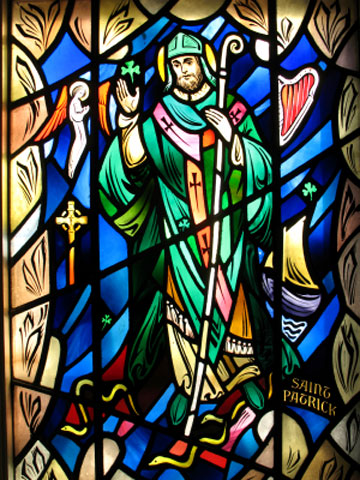In my youth, St. Patrick’s Day was most of all a day to wear green. Be caught without green and you got pinched by your friends, maybe even your teacher. (That was a long time ago, when teachers dared such things!) To my youthful self, St. Patrick seemed to be the patron saint of greenness and pinching. And if he was ever pictured, he looked suspiciously like a leprechaun.
 On March 17, 1982, I found myself in New Haven, Connecticut. (Yes, a Harvard man in Yale territory, I confess.) Little did I know that I had wandered into one of the oldest and most enthusiastic celebrations of St. Patrick’s Day in America. All the downtown pubs sold green beer (!) for a dime. Crowds gathered for the annual parade. I was caught up in a tidal wave of humanity who were “painting the town green,” if you will.
On March 17, 1982, I found myself in New Haven, Connecticut. (Yes, a Harvard man in Yale territory, I confess.) Little did I know that I had wandered into one of the oldest and most enthusiastic celebrations of St. Patrick’s Day in America. All the downtown pubs sold green beer (!) for a dime. Crowds gathered for the annual parade. I was caught up in a tidal wave of humanity who were “painting the town green,” if you will.
At that time I had some vague idea that there was a real St. Patrick, a Christian missionary of days gone by. Yet it was hard to find the connection between St. Patrick’s Christian mission in Ireland and the mass consumption of green beer. Later I did a bit of research to find out something about the historical St. Patrick.
His story reads like an Indiana Jones-type adventure. Raised in Britain (yes, not Ireland), Patrick was captured by pirates in A.D. 405 when he was only sixteen years old. The kidnappers whisked him away to Ireland and sold Patrick into slavery. He spent eight years as a captive in this pagan land.
During his captivity, Patrick embraced the Christian faith of his upbringing, something that had mattered little to him beforehand. In his own words, Patrick explained: “And there the Lord opened the sense of my unbelief that I might at last remember my sins and be converted with all my heart to the Lord my God, who had regard for my abjection, and mercy on my youth and ignorance, and watched over me before I knew Him, and before I was able to distinguish between good and evil, and guarded me, and comforted me as would a father his son” (from The Confession of St. Patrick).
 Inspired by a dream, Patrick finally escaped from Ireland and made his way back to his home in Britain. But, in time, he sensed God’s call to return to Ireland, of all places, in order to share the good news of Christ with the pagans there. Even though he feared he wasn’t sufficiently learned to be a missionary, Patrick returned to Ireland, where he found unprecedented success in his evangelistic endeavors. His experience of Irish language and culture during his years as a slave enabled Patrick to communicate the Christian gospel with unusual effectiveness. (Photo: A stained-glass image of St. Patrick, from St. Peter’s Church in Washington D.C. Photo from iStockphoto.com.)
Inspired by a dream, Patrick finally escaped from Ireland and made his way back to his home in Britain. But, in time, he sensed God’s call to return to Ireland, of all places, in order to share the good news of Christ with the pagans there. Even though he feared he wasn’t sufficiently learned to be a missionary, Patrick returned to Ireland, where he found unprecedented success in his evangelistic endeavors. His experience of Irish language and culture during his years as a slave enabled Patrick to communicate the Christian gospel with unusual effectiveness. (Photo: A stained-glass image of St. Patrick, from St. Peter’s Church in Washington D.C. Photo from iStockphoto.com.)
Though we can’t be sure when Patrick died, tradition holds that he lived into his seventies and died on March 17 in the latter half of the fifth-century A.D. In twenty-five or thirty years of evangelistic work, he led thousands of Irish pagans to Christ and was responsible for Ireland’s becoming one of the most Christian nations in Europe. For this reason he is called “the apostle of the Irish.”
The story of Patrick reminds me, in a way, of Joseph’s experience in Egypt. In both cases, what kidnappers and slave masters intended for evil, God intended for good (Gen 50:20). Today I want to celebrate, not only Patrick’s example of faithfulness, but also the mystery and majesty of God’s redemptive sovereignty. It’s not unusual for people who have experienced some particular trauma in life to end up ministering to others who suffer that same trauma. A friend of mine, for example, who was sexually abused by her pastor when she was a teenager, now has a tenderhearted ministry to women who have experienced similar abuse. Thus, St. Patrick serves as an example of how God can work all things together for good, even things which are quite evil.
It is appropriate to close this piece with an excerpt from a prayer that is attributed to Patrick. Whether he actually wrote it or not, this prayer captures the boldness of his Christian faith:
Christ with me, Christ before me,
Christ behind me, Christ within me,
Christ beneath me, Christ above me,
Christ at my right, Christ at my left, . . .
Christ in the heart of everyone who thinks of me,
Christ in the mouth of everyone who speaks to me,
Christ in every eye that sees me,
Christ in every ear that hears me.
I bind to myself today
The strong virtue of an invocation of the Trinity,
I believe the Trinity in the Unity
The Creator of the Universe.

